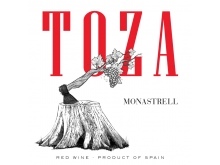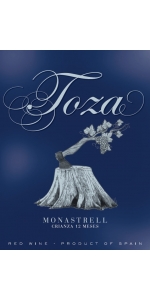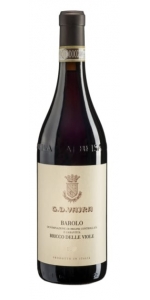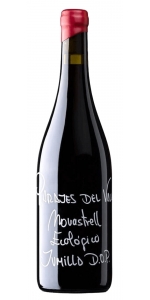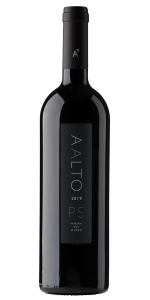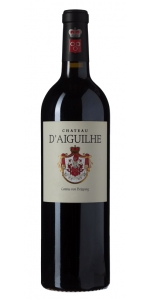Toza Jumilla Monastrell 2019
| Country: | Spain |
| Region: | Jumilla |
| Winery: | San Dionisio |
| Grape Type: | Mourvedre |
| Organic: | Yes |
| Vintage: | 2019 |
| Bottle Size: | 750 ml |
Toza Crianza Jumilla is made from 100% Monastrell (Mourvedre). Toza Crianza is a classic example of the Monastrell variety from the Mediterranean region, made from hand harvested old vines and aged 12 months in oak barrels. This Spanish red is rich, toasty, round and velvety.
Review:
Review:
"Opaque ruby. Dark berries, coconut and a hint of spiciness on the powerfully scented nose. In a round and generous style, showing very good depth and appealing sweetness to the blackberry and cherry cola flavors. Soft, even tannins add gentle grip to a long, smooth finish that leaves hints of vanilla and dark fruits behind. Raised in a combination of French and American oak barrels. - Josh Raynolds"
- Antonio Galloni's Vinous (March 2021), 90 pts
Toza Crianza Jumilla is made from 100% Monastrell (Mourvedre). Toza Crianza is a classic example of the Monastrell variety from the Mediterranean region, made from hand harvested old vines and aged 12 months in oak barrels. This Spanish red is rich, toasty, round and velvety.
Pair with red meat and game casseroles and well-cured cheeses.
G.D. Vajra Bricco Delle Viole Barolo is made from 100 percent Nebbiolo.
The Barolo Bricco delle Viole shows the signature verticality of its vineyard. The wine is beautifully layered and - while restrained as it’s always the case in the youth of Bricco delle Viole - it also shows a complexity of layers with purple flowers, sweet spices and mineral tones. The palate is noble, with a refined acid spine and profound tannins that promise a long aging potential.
Among the historical vineyards of Barolo, Bricco delle Viole is the highest and the closest to the Alps. It rises from 400 to 480 meters above sea level, on the Western ridge of the village. Its name, “Hill of Violets”, originates from the flowers that blossom early here due to the perfect south exposure. Up above the fogs, Bricco delle Viole enjoys the earliest sunrise and the last sunset every day. Thanks to its vines dating back to 1949 and -now- 1931, a dramatic diuturnal temperature range and this pure light, Bricco delle Viole generates a sophisticated and profound Barolo DOCG of bright aromatics, chiseled tannins and subtle minerality. 2018 is a vintage that shows many nuances of Bricco delle Viole: beyond the signature verticality of this site, the wine offers high tones laced with mineral nuances and plenty of energy and youth.
Review:
A juicy Barolo, with vibrant acidity and a fluid profile that exudes cherry, raspberry, mown hay, mineral and eucalyptus aromas and flavors. Tight yet long, with excellent potential.
#26 Wine Spectator Top 100 of 2023
The last wine poured at my tasting at the winery is the G.D. Vajra 2019 Barolo Bricco delle Viole. With its high vantage point in the hills west of Barolo, Bricco delle Viole is a world apart in terms of soils (with Sant'Agata marl and fossils) and even harvest times. Slow and careful ripening like the kind that characterizes fruit in 2019 renders a very delicate and ethereal expression with floral tones, wild mint and licorice. This organic wine is solid in build and structure. Indeed, Isidoro Vaira remarks that Nebbiolo tannins have changed since the 1970s and 1980s.
-Wine Advocate 97+ Points
Jeweled in appearance, the 2019 Barolo Bricco Delle Viole may be the best wine I have tried yet from Vajra. Its gorgeous and alluring perfume of fresh roses is followed by a Burgundian, elegant red with incredible length and no harsh edges, fine and present tannins, and beautiful, graceful concentration. It is drinking well now, and I will be trying to get my hands on as much of this as possible. Drink 2025-2045.
-Jeb Dunnuck 97 Points
Full of life, crispy red fruit, with balsamic notes, easy to drink, representing the Mediterranean character.
As a light red wine, it pairs well with tapas, charcuterie, rice dishes, or pizza. It can even complement desserts. The high acidity will take you on a surprising journey.
Aalto P.S. Pagos Seleccionados Tinto is made from 100 percent Tempranillo.
Climatic conditions
The farming year began with a mild autumn and little precipitation. A very dry winter started with -9ºC reaching at the end higher temperatures than normal for that time of the year. Spring and summer characterized by little rain, only some rain showers in July and late August avoided the hydric stress of the vines. The vegetative cycle of the vine developed with big variations of temperatures, alternating warm and atypical low temperatures of 4ºC for mid-June. The ripening of the grapes happened under very good conditions and the harvest started on 24th September 2019.
Grape origin
100% Tinto Fino (Tempranillo) primarily from very old vines – 60 to 90 years old – from selected plots in La Horra and La Aguilera. The harvest was done by hand, in small boxes of 15 kilos that are thoroughly inspected, bunch by bunch, on the selection table.
Tasting notes
Average oak ageing
Aged for 21 months in new French oak barrels.
Review:
Color: dark cherry, Aroma: toasty, spicy, fine cocoa, black fruit, Mouth: tasty, toasty, fine bitterness, ripe tannins
Guia Penin 94 Points
This wine reveals a complex and elegant bouquet that combines ripe fruit, leather and a fine woodiness. Round and warm on the attack, the palate is supported by solid tannins and a pleasant freshness in this harmonious and well textured wine.
The Merlot bring fruity notes and minerality from the clay-limestone terroir, enhanced by the incredibly expressive and spicy Cabernet Franc.
Review:
"A terrific effort from this large and immaculately maintained property on the clay-limestone slopes of the Côtes de Castillon, the 2019 d'Aiguilhe exhibits aromas of cherries and cassis mingled with notions of burning embers, licorice and warm spices. Medium to full-bodied, layered and concentrated, with lively acids, powdery tannins and a mineral finish, it's intelligently matured in tank and large-format oak as well as small barriques. - William Kelley"
- Robert Parker's Wine Advocate (April 2022), 92 pts
"The 2019 d'Aiguilhe has a really lovely bouquet of ample black cherry, mulberry and light floral scents, very pure and delineated. The palate is medium-bodied with cedar-infused red fruit. While not as exuberant as the aromatics, this is nicely detailed and quite poised on the finish. No, I still cannot pronounce its name, but this Castillon Côtes de Bordeaux is well worth seeking out. - Neal Martin"
- Antonio Galloni's Vinous (February 2022), 92 pts
Toza Jumilla Monastrell is made from 100 percent Monastrell.
Toza is a classic example of the Monastrell variety from the Mediterranean region. Clean, bright cherry red color. It is bold with intense fresh red fruits and varietal aromas on the nose. Aged in oak barrels, this Spanish red is rich, toasty, round and velvety.
Bodegas San Dionisio is located in the town of Fuenteálamo in Albacete (Castilla – La Mancha). For centuries, from generation to generation, the winemakers have developed cultivation techniques to take full advantage of the exceptionally hard conditions of the climate and soil. The result is a small production (3,000 kilos per hectare) and a slow ripening process (the most common variety – Monastrell – is harvested at the end of September and all of October) that produces very complex wines with a strong personality, high concentration of aromas and polyphenols.
Toza Crianza Jumilla is made from 100% Monastrell (Mourvedre). Toza Crianza is a classic example of the Monastrell variety from the Mediterranean region, made from hand harvested old vines and aged 12 months in oak barrels. This Spanish red is rich, toasty, round and velvety.
Review:
Review:
"Opaque ruby. Dark berries, coconut and a hint of spiciness on the powerfully scented nose. In a round and generous style, showing very good depth and appealing sweetness to the blackberry and cherry cola flavors. Soft, even tannins add gentle grip to a long, smooth finish that leaves hints of vanilla and dark fruits behind. Raised in a combination of French and American oak barrels. - Josh Raynolds"
- Antonio Galloni's Vinous (March 2021), 90 pts
- back
All older vintage wines have been purchased from a single collectors cellar. Pictures can be requested before shipment.
Le Jade Picpoul de Pinet is made from 100% Picpoul de Pinet
Pale straw color. Delicate white flower, citrus and juicy pear aromas. Fresh, crisp, and bright acidity with mineral and saline accents. Well-balanced and easy-drinking.
A refreshing treat laced up with snappy food-friendly acidity.
Picpoul Le Jade makes a classic match with oysters on the half shell and goes very well with exotic food in general. Picpoul means lip-smacking good.
SOIL : Clay and limestone soil just a few kilometres from the reputed Etang de Thau (salted water lagoon) overlooking the Mediterranean town of Sète.
VINIFICATION : Grapes are harvested at 12°- 13° maturity
Skin maceration for several hours
Selection of drained juice after undergoing pneumatic pressure.
Cold double decantation.
Thermoregulated fermentation at 16°C
No malolactic fermentation.

